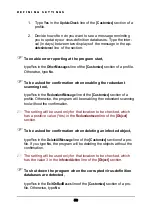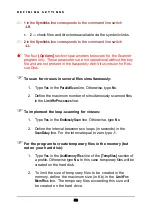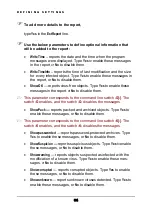
D A E M O N
-o{the list of files, directories or symbolic links separated by colons}
checks the defined files, directories and links. If the objects are not lo-
cated in the check-permitted area, they will be ignored.
-f=directoryname
creates and stores the files AvpCtl and AvpPid in the defined directory.
If you do not start Daemon from under the
root
user, the program may
be prohibited from accessing the default directory for these files. In this
case every time you start Daemon, make sure to use the switch
-f
.
-WU[=temporaryfilename]
the temporary file for the daemon process to log check-results.
In this version when you launch the daemon process, it automatically initi-
ates the following two processes: the primary process handles calls from
the client programs, the secondary process reports performance of the first.
It is possible to disable the second process
.
-dl
—
disables start of the secondary daemon process.
The Daemon command line may look
similar to the following:
./kavdaemon /home -o{/home/my_mail} -A -K
When started the Daemon program
first checks for any daemon process
running
.
If it is not detected, Daemon will act similar to the anti-virus scanner (see
subchapter 4.2), then it will start the daemon process. This is only if you
didn't use the command line switch
-q
. However, if the switch is in the
command line, the daemon process will not be started.
If the process has been started, the Daemon program establishes a
data link with it and uses this link to transfer the command string with
scanning settings. Then the daemon process checks and deletes vi-
ruses and uses this link to record the check results. When the check is
finished the program breaks the link.
68
















































